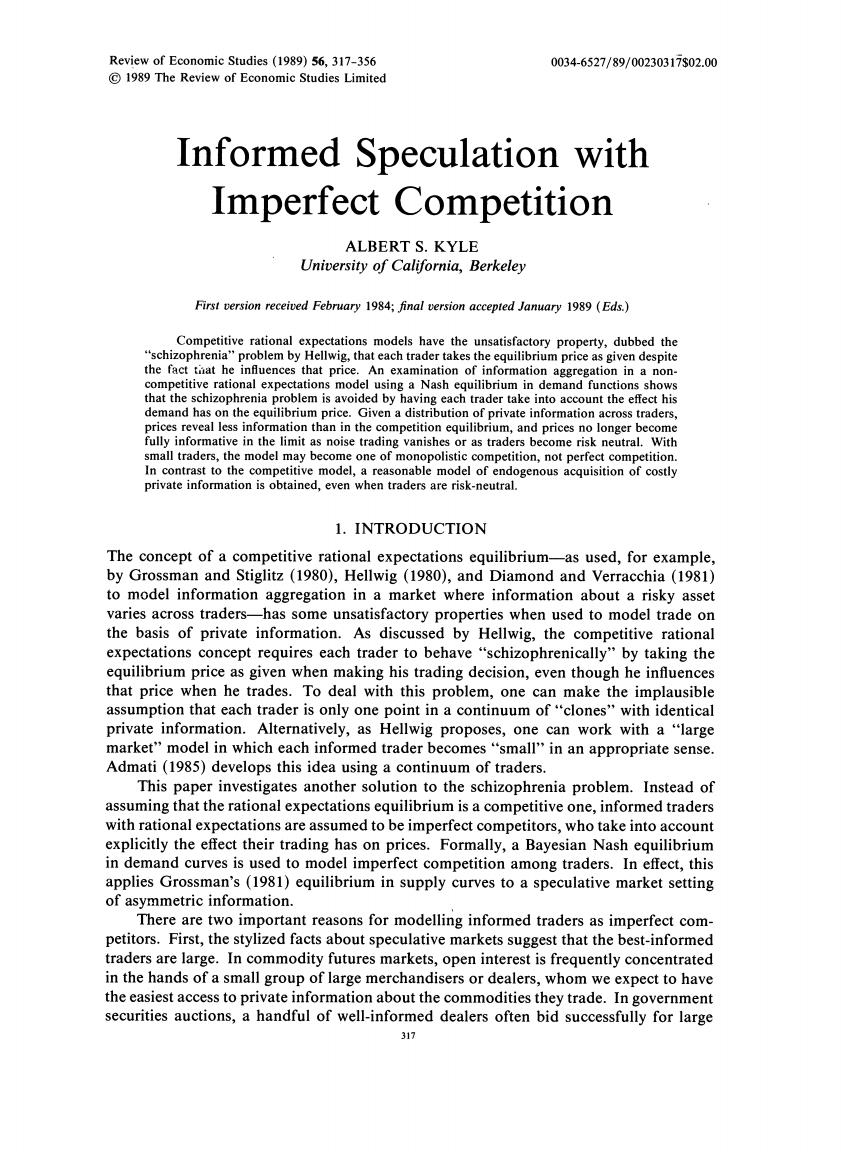
Review of Economic Studies (1989)56,317-356 0034-6527/89/00230317$02.00 C 1989 The Review of Economic Studies Limited Informed Speculation with Imperfect Competition ALBERT S.KYLE University of California,Berkeley First version received February 1984;final version accepted January 1989 (Eds.) Competitive rational expectations models have the unsatisfactory property,dubbed the "schizophrenia"problem by Hellwig,that each trader takes the equilibrium price as given despite the fact tiat he influences that price.An examination of information aggregation in a non- competitive rational expectations model using a Nash equilibrium in demand functions shows that the schizophrenia problem is avoided by having each trader take into account the effect his demand has on the equilibrium price.Given a distribution of private information across traders, prices reveal less information than in the competition equilibrium,and prices no longer become fully informative in the limit as noise trading vanishes or as traders become risk neutral.With small traders,the model may become one of monopolistic competition,not perfect competition. In contrast to the competitive model,a reasonable model of endogenous acquisition of costly private information is obtained,even when traders are risk-neutral. 1.INTRODUCTION The concept of a competitive rational expectations equilibrium-as used,for example, by Grossman and Stiglitz (1980),Hellwig (1980),and Diamond and Verracchia (1981) to model information aggregation in a market where information about a risky asset varies across traders-has some unsatisfactory properties when used to model trade on the basis of private information.As discussed by Hellwig,the competitive rational expectations concept requires each trader to behave "schizophrenically"by taking the equilibrium price as given when making his trading decision,even though he influences that price when he trades.To deal with this problem,one can make the implausible assumption that each trader is only one point in a continuum of"clones"with identical private information.Alternatively,as Hellwig proposes,one can work with a "large market"model in which each informed trader becomes"small"in an appropriate sense. Admati (1985)develops this idea using a continuum of traders. This paper investigates another solution to the schizophrenia problem.Instead of assuming that the rational expectations equilibrium is a competitive one,informed traders with rational expectations are assumed to be imperfect competitors,who take into account explicitly the effect their trading has on prices.Formally,a Bayesian Nash equilibrium in demand curves is used to model imperfect competition among traders.In effect,this applies Grossman's (1981)equilibrium in supply curves to a speculative market setting of asymmetric information. There are two important reasons for modelling informed traders as imperfect com- petitors.First,the stylized facts about speculative markets suggest that the best-informed traders are large.In commodity futures markets,open interest is frequently concentrated in the hands of a small group of large merchandisers or dealers,whom we expect to have the easiest access to private information about the commodities they trade.In government securities auctions,a handful of well-informed dealers often bid successfully for large 317
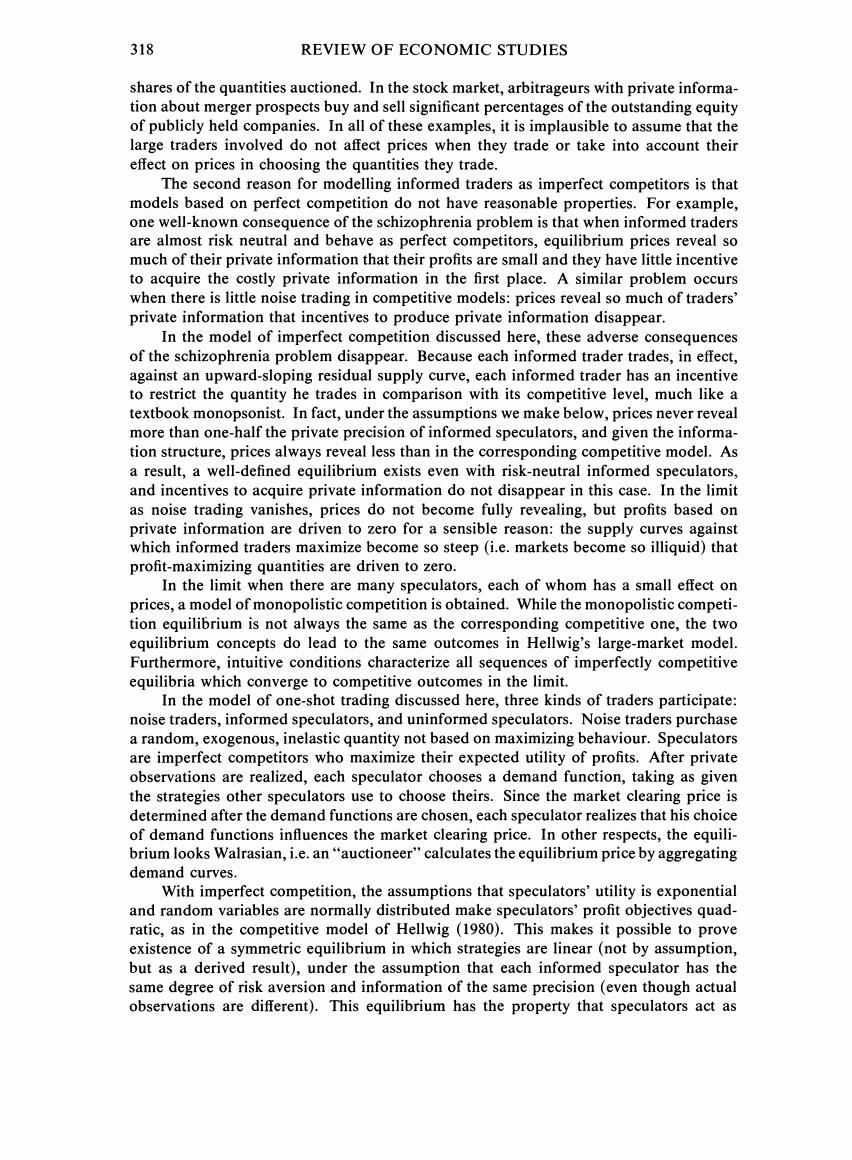
318 REVIEW OF ECONOMIC STUDIES shares of the quantities auctioned.In the stock market,arbitrageurs with private informa- tion about merger prospects buy and sell significant percentages of the outstanding equity of publicly held companies.In all of these examples,it is implausible to assume that the large traders involved do not affect prices when they trade or take into account their effect on prices in choosing the quantities they trade. The second reason for modelling informed traders as imperfect competitors is that models based on perfect competition do not have reasonable properties.For example, one well-known consequence of the schizophrenia problem is that when informed traders are almost risk neutral and behave as perfect competitors,equilibrium prices reveal so much of their private information that their profits are small and they have little incentive to acquire the costly private information in the first place.A similar problem occurs when there is little noise trading in competitive models:prices reveal so much of traders' private information that incentives to produce private information disappear. In the model of imperfect competition discussed here,these adverse consequences of the schizophrenia problem disappear.Because each informed trader trades,in effect, against an upward-sloping residual supply curve,each informed trader has an incentive to restrict the quantity he trades in comparison with its competitive level,much like a textbook monopsonist.In fact,under the assumptions we make below,prices never reveal more than one-half the private precision of informed speculators,and given the informa- tion structure,prices always reveal less than in the corresponding competitive model.As a result,a well-defined equilibrium exists even with risk-neutral informed speculators, and incentives to acquire private information do not disappear in this case.In the limit as noise trading vanishes,prices do not become fully revealing,but profits based on private information are driven to zero for a sensible reason:the supply curves against which informed traders maximize become so steep (i.e.markets become so illiquid)that profit-maximizing quantities are driven to zero. In the limit when there are many speculators,each of whom has a small effect on prices,a model of monopolistic competition is obtained.While the monopolistic competi- tion equilibrium is not always the same as the corresponding competitive one,the two equilibrium concepts do lead to the same outcomes in Hellwig's large-market model. Furthermore,intuitive conditions characterize all sequences of imperfectly competitive equilibria which converge to competitive outcomes in the limit. In the model of one-shot trading discussed here,three kinds of traders participate: noise traders,informed speculators,and uninformed speculators.Noise traders purchase a random,exogenous,inelastic quantity not based on maximizing behaviour.Speculators are imperfect competitors who maximize their expected utility of profits.After private observations are realized,each speculator chooses a demand function,taking as given the strategies other speculators use to choose theirs.Since the market clearing price is determined after the demand functions are chosen,each speculator realizes that his choice of demand functions influences the market clearing price.In other respects,the equili- brium looks Walrasian,i.e.an"auctioneer"calculates the equilibrium price by aggregating demand curves. With imperfect competition,the assumptions that speculators'utility is exponential and random variables are normally distributed make speculators'profit objectives quad- ratic,as in the competitive model of Hellwig (1980).This makes it possible to prove existence of a symmetric equilibrium in which strategies are linear(not by assumption, but as a derived result),under the assumption that each informed speculator has the same degree of risk aversion and information of the same precision(even though actual observations are different).This equilibrium has the property that speculators act as

KYLE INFORMED SPECULATION 319 monopsonists who observe their residual supply curves and utilize any information which the levels of these supply curves reveal about the liquidation value of the commodity. The plan of this paper is as follows.Section 2 outlines the basic structure,establishes notation,and makes special assumptions.Section 3 defines a rational expectations equilibrium with imperfect competition and provides a conceptual discussion of the particular equilibrium concept chosen.Section 4 introduces some indices measuring informational efficiency;these are useful in discussing both competitive and imperfectly competitive equilibria when linearity is assumed.Section 5 characterizes the unique symmetric rational expectations equilibrium with imperfect competition which has the property that optimal trading strategies are linear.Section 6 contains an analogous characterization of the competitive equilibrium,for the purpose of facilitating comparisons between the two.Section 7 compares the indices measuring the informativeness of prices which result from the two equilibrium concepts.Section 8 discusses the properties of equilibrium when the number of informed speculators is large.Section 9 shows how the model with imperfect competition can become one of monopolistic competition when traders are small,and characterizes all sequences of exogenous parameters in which the competitive and imperfectly competitive concepts have non-trivial,informationally equivalent limits.Section 10 introduces endogenous acquisition of costly private informa- tion,and shows that the strange properties of equilibrium associated with the"informa- tional efficiency"paradox go away when imperfect competition is introduced.Section 11 concludes by suggesting that since the equilibrium with imperfect competition is intellectually sensible and leads to properties different from those of the competitive equilibrium in important respects,its thorough study is justified. 2.STRUCTURE AND NOTATION Trading takes place in a one-period,partial equilibrium framework.A single risky asset is traded at a market clearing price p,realizes after trade occurs an exogenous liquidation value and thus generates returns o-p.Three kinds of traders participate in the market: noise traders,informed speculators,and uninformed speculators. Noise traders trade in aggregate an exogenous random quantity Z,which is not(in this paper)based on maximizing behaviour. There are N informed speculators,indexed n=1,...,N,and M uninformed specu- lators,indexed m=1,...,M.Each informed speculator is endowed with unique private information,represented as the outcome of a random variable in.After observing his private signal in,each informed speculator chooses a demand schedule X(;i)which depends upon that signal.Each uninformed trader chooses a demand schedule Ym(). The schedules X and Ym are the speculators'strategies.Given a market clearing price p,the quantities traded by informed and uninformed speculators can be written xn=Xn(p,in),n=1,...,N;ym=Ym(p),m=1,...,M. (1) In this notation,a tilde distinguishes a random variable from its realization.Thus, denotes the random variable generating the quantity traded by the nth informed trader, and xn is the quantity traded for a particular realization of.Similarly,X(;in)is a random variable defined over demand schedules,while X(,i)is a particular demand schedule corresponding to a particular realization of in.These are both different from X,the strategy rule of the nth informed speculator.We can interpret X either as a mapping from R'to R (i.e.X.=X(,))or as a mapping from R to the space of demand schedules (i.e.X=X(;))
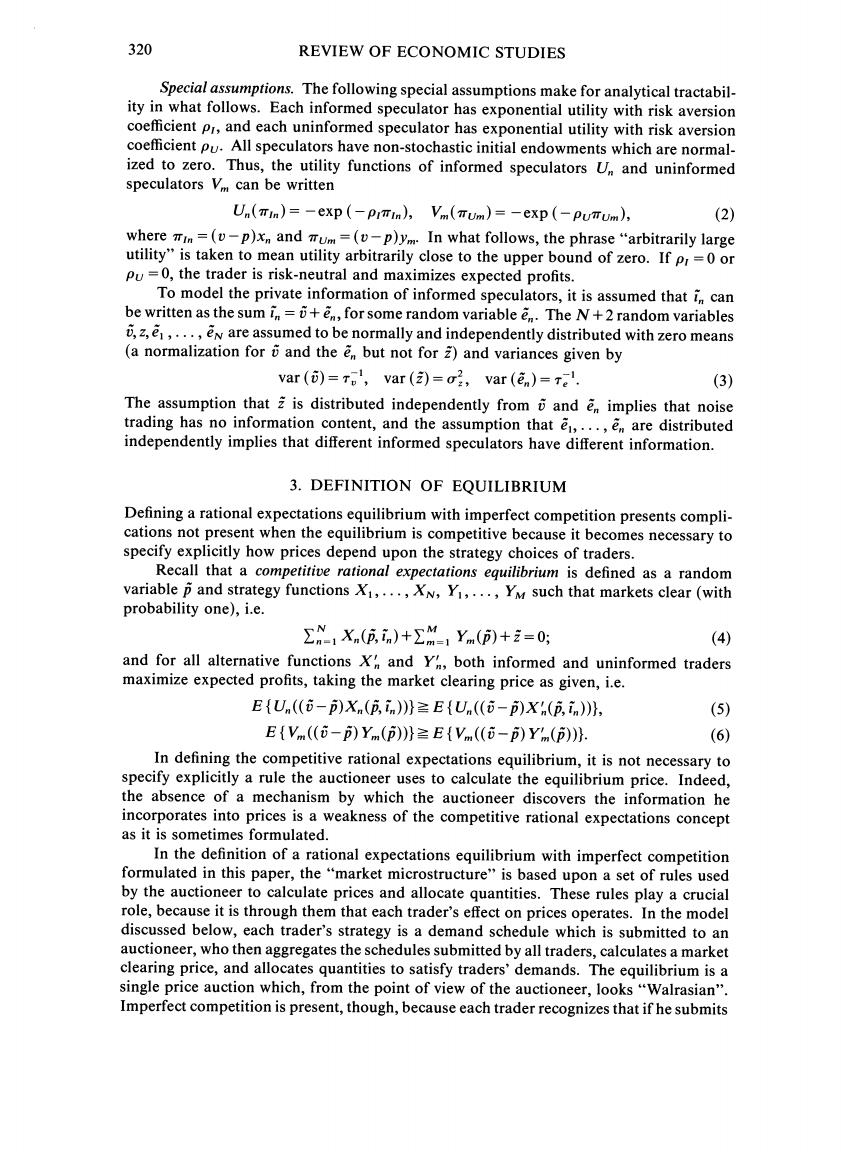
320 REVIEW OF ECONOMIC STUDIES Special assumptions.The following special assumptions make for analytical tractabil- ity in what follows.Each informed speculator has exponential utility with risk aversion coefficient pr,and each uninformed speculator has exponential utility with risk aversion coefficient Pu.All speculators have non-stochastic initial endowments which are normal- ized to zero.Thus,the utility functions of informed speculators U and uninformed speculators Vm can be written Un(TIn)=-exp(-prTIn),Vm(Tum)=-exp (-PuTUm), (2) where Tin=(v-p)xn and Tum =(v-p)ym.In what follows,the phrase "arbitrarily large utility"is taken to mean utility arbitrarily close to the upper bound of zero.If pr=0 or Pu =0,the trader is risk-neutral and maximizes expected profits. To model the private information of informed speculators,it is assumed that in can be written as the sum in=+,for some random variable en.The N+2 random variables ,z,e1,...,ew are assumed to be normally and independently distributed with zero means (a normalization for and the en but not for 2)and variances given by var ()=T,var ()=2,var (n)=Te. (3) The assumption that is distributed independently from and en implies that noise trading has no information content,and the assumption that e,...,e are distributed independently implies that different informed speculators have different information. 3.DEFINITION OF EQUILIBRIUM Defining a rational expectations equilibrium with imperfect competition presents compli- cations not present when the equilibrium is competitive because it becomes necessary to specify explicitly how prices depend upon the strategy choices of traders. Recall that a competitive rational expectations equilibrium is defined as a random variable p and strategy functions X1,...,XN,Y1,...,YM such that markets clear(with probability one),i.e. ,X.(ii)+∑M,y()+=0: (4) and for all alternative functions X and Y,both informed and uninformed traders maximize expected profits,taking the market clearing price as given,i.e. EU((p)xn(p,in)))EU((-p)xh(p,in))), (5) EVm ((-p)Ym(p))Ev((-p)Ym(p))). (6) In defining the competitive rational expectations equilibrium,it is not necessary to specify explicitly a rule the auctioneer uses to calculate the equilibrium price.Indeed, the absence of a mechanism by which the auctioneer discovers the information he incorporates into prices is a weakness of the competitive rational expectations concept as it is sometimes formulated. In the definition of a rational expectations equilibrium with imperfect competition formulated in this paper,the "market microstructure"is based upon a set of rules used by the auctioneer to calculate prices and allocate quantities.These rules play a crucial role,because it is through them that each trader's effect on prices operates.In the model discussed below,each trader's strategy is a demand schedule which is submitted to an auctioneer,who then aggregates the schedules submitted by all traders,calculates a market clearing price,and allocates quantities to satisfy traders'demands.The equilibrium is a single price auction which,from the point of view of the auctioneer,looks"Walrasian". Imperfect competition is present,though,because each trader recognizes that if he submits
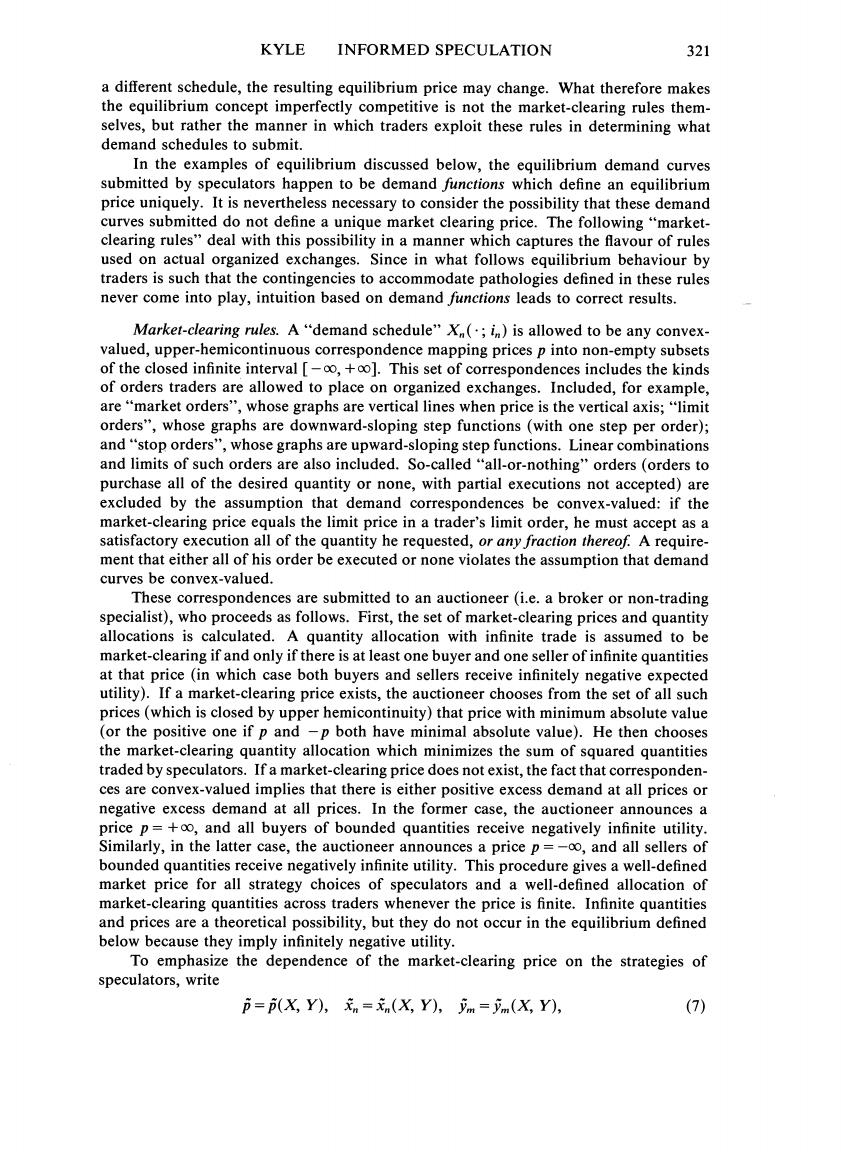
KYLE INFORMED SPECULATION 321 a different schedule,the resulting equilibrium price may change.What therefore makes the equilibrium concept imperfectly competitive is not the market-clearing rules them- selves,but rather the manner in which traders exploit these rules in determining what demand schedules to submit. In the examples of equilibrium discussed below,the equilibrium demand curves submitted by speculators happen to be demand functions which define an equilibrium price uniquely.It is nevertheless necessary to consider the possibility that these demand curves submitted do not define a unique market clearing price.The following"market- clearing rules"deal with this possibility in a manner which captures the flavour of rules used on actual organized exchanges.Since in what follows equilibrium behaviour by traders is such that the contingencies to accommodate pathologies defined in these rules never come into play,intuition based on demand functions leads to correct results Market-clearing rules.A"demand schedule"Xn(;in)is allowed to be any convex- valued,upper-hemicontinuous correspondence mapping prices p into non-empty subsets of the closed infinite interval [-oo,+oo].This set of correspondences includes the kinds of orders traders are allowed to place on organized exchanges.Included,for example, are"market orders",whose graphs are vertical lines when price is the vertical axis;"limit orders",whose graphs are downward-sloping step functions (with one step per order); and"stop orders",whose graphs are upward-sloping step functions.Linear combinations and limits of such orders are also included.So-called "all-or-nothing"orders (orders to purchase all of the desired quantity or none,with partial executions not accepted)are excluded by the assumption that demand correspondences be convex-valued:if the market-clearing price equals the limit price in a trader's limit order,he must accept as a satisfactory execution all of the quantity he requested,or any fraction thereof.A require- ment that either all of his order be executed or none violates the assumption that demand curves be convex-valued. These correspondences are submitted to an auctioneer (i.e.a broker or non-trading specialist),who proceeds as follows.First,the set of market-clearing prices and quantity allocations is calculated.A quantity allocation with infinite trade is assumed to be market-clearing if and only if there is at least one buyer and one seller of infinite quantities at that price (in which case both buyers and sellers receive infinitely negative expected utility).If a market-clearing price exists,the auctioneer chooses from the set of all such prices(which is closed by upper hemicontinuity)that price with minimum absolute value (or the positive one if p and -p both have minimal absolute value).He then chooses the market-clearing quantity allocation which minimizes the sum of squared quantities traded by speculators.If a market-clearing price does not exist,the fact that corresponden- ces are convex-valued implies that there is either positive excess demand at all prices or negative excess demand at all prices.In the former case,the auctioneer announces a price p=+oo,and all buyers of bounded quantities receive negatively infinite utility. Similarly,in the latter case,the auctioneer announces a price p=-oo,and all sellers of bounded quantities receive negatively infinite utility.This procedure gives a well-defined market price for all strategy choices of speculators and a well-defined allocation of market-clearing quantities across traders whenever the price is finite.Infinite quantities and prices are a theoretical possibility,but they do not occur in the equilibrium defined below because they imply infinitely negative utility. To emphasize the dependence of the market-clearing price on the strategies of speculators,write p=(X,Y),xn=元n(X,Y),ym=少m(X,Y), (7)
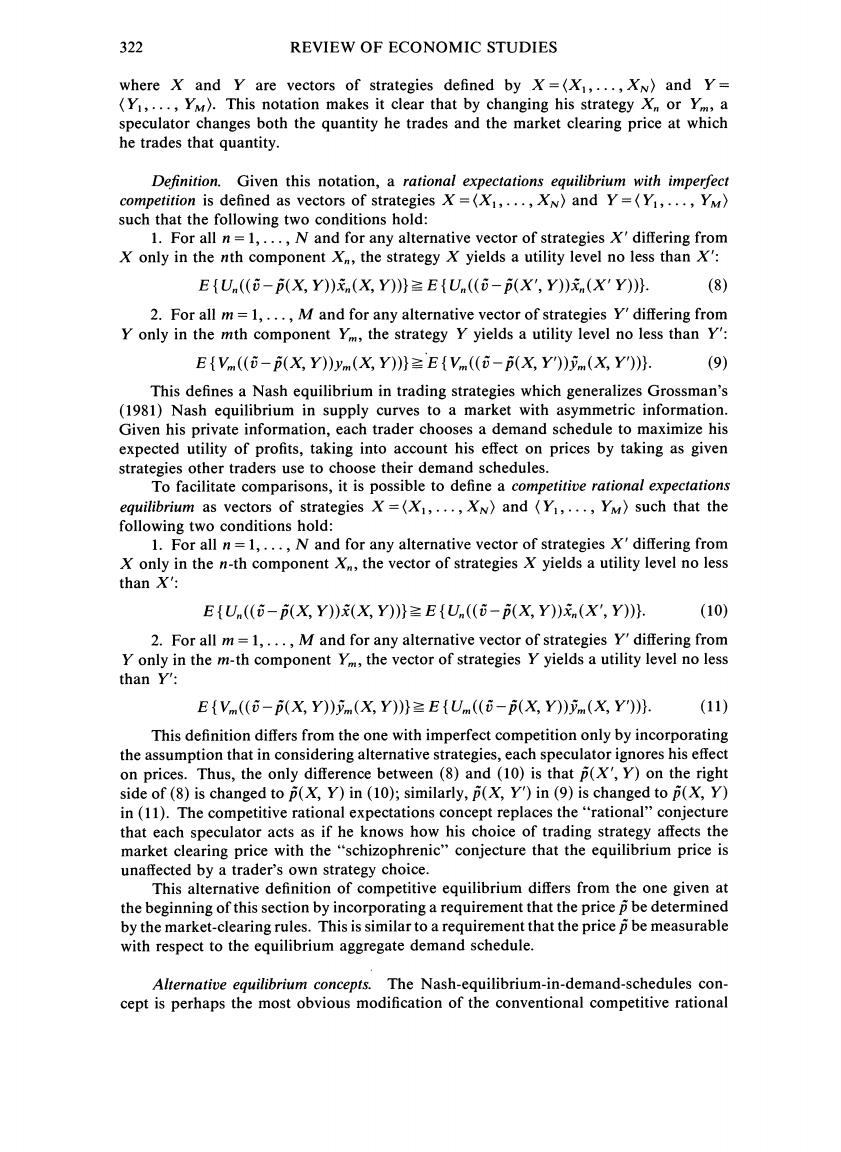
322 REVIEW OF ECONOMIC STUDIES where X and Y are vectors of strategies defined by X=(X1,...,XN)and Y= (Y1,...,YM).This notation makes it clear that by changing his strategy X or Yim,a speculator changes both the quantity he trades and the market clearing price at which he trades that quantity. Definition.Given this notation,a rational expectations equilibrium with imperfect competition is defined as vectors of strategies X=(X1,...,XN)and Y=(Y1,...,YM) such that the following two conditions hold: 1.For all n=1,...,N and for any alternative vector of strategies X'differing from X only in the nth component X,the strategy X yields a utility level no less than X': EU(((X,Y))(X,Y))EU((-(X',Y))(X'Y))) (8) 2.For all m=1,...,M and for any alternative vector of strategies Y'differing from Y only in the mth component Yim,the strategy Y yields a utility level no less than Y': EV ((-(X,Y))vm(X,Y))EV ((6-p(X,Y))(X,Y))) (9) This defines a Nash equilibrium in trading strategies which generalizes Grossman's (1981)Nash equilibrium in supply curves to a market with asymmetric information. Given his private information,each trader chooses a demand schedule to maximize his expected utility of profits,taking into account his effect on prices by taking as given strategies other traders use to choose their demand schedules. To facilitate comparisons,it is possible to define a competitive rational expectations equilibrium as vectors of strategies X=(X1,...,XN)and (Y1,...,Ym)such that the following two conditions hold: 1.For all n=1,...,N and for any alternative vector of strategies X'differing from X only in the n-th component X,the vector of strategies X yields a utility level no less than X': EU((-(X,Y))X,Y)))EU((-(X,Y))(X',Y))). (10) 2.For all m=1,...,M and for any alternative vector of strategies Y'differing from Y only in the m-th component Ym,the vector of strategies Y yields a utility level no less than Y: EV((-p(X,Y))(X,Y))EU((-(X,Y))(X,Y))). (11) This definition differs from the one with imperfect competition only by incorporating the assumption that in considering alternative strategies,each speculator ignores his effect on prices.Thus,the only difference between (8)and (10)is that p(X',Y)on the right side of (8)is changed to p(X,Y)in (10);similarly,p(X,Y')in (9)is changed to p(X,Y) in (11).The competitive rational expectations concept replaces the"rational"conjecture that each speculator acts as if he knows how his choice of trading strategy affects the market clearing price with the "schizophrenic"conjecture that the equilibrium price is unaffected by a trader's own strategy choice. This alternative definition of competitive equilibrium differs from the one given at the beginning of this section by incorporating a requirement that the price p be determined by the market-clearing rules.This is similar to a requirement that the price p be measurable with respect to the equilibrium aggregate demand schedule. Alternative equilibrium concepts.The Nash-equilibrium-in-demand-schedules con- cept is perhaps the most obvious modification of the conventional competitive rational
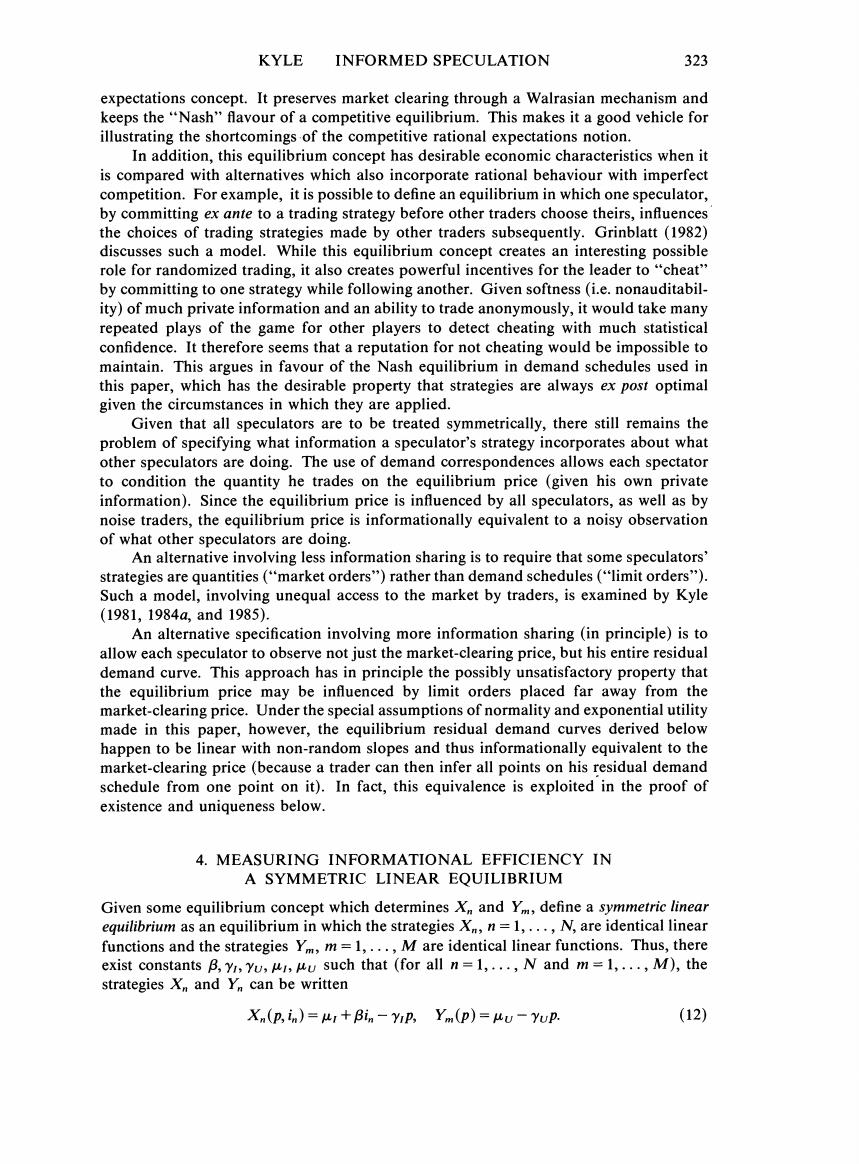
KYLE INFORMED SPECULATION 323 expectations concept.It preserves market clearing through a Walrasian mechanism and keeps the"Nash"flavour of a competitive equilibrium.This makes it a good vehicle for illustrating the shortcomings of the competitive rational expectations notion. In addition.this equilibrium concept has desirable economic characteristics when it is compared with alternatives which also incorporate rational behaviour with imperfect competition.For example,it is possible to define an equilibrium in which one speculator, by committing ex ante to a trading strategy before other traders choose theirs,influences the choices of trading strategies made by other traders subsequently.Grinblatt(1982) discusses such a model.While this equilibrium concept creates an interesting possible role for randomized trading,it also creates powerful incentives for the leader to"cheat" by committing to one strategy while following another.Given softness(i.e.nonauditabil- ity)of much private information and an ability to trade anonymously,it would take many repeated plays of the game for other players to detect cheating with much statistical confidence.It therefore seems that a reputation for not cheating would be impossible to maintain.This argues in favour of the Nash equilibrium in demand schedules used in this paper,which has the desirable property that strategies are always ex post optimal given the circumstances in which they are applied. Given that all speculators are to be treated symmetrically,there still remains the problem of specifying what information a speculator's strategy incorporates about what other speculators are doing.The use of demand correspondences allows each spectator to condition the quantity he trades on the equilibrium price (given his own private information).Since the equilibrium price is influenced by all speculators,as well as by noise traders,the equilibrium price is informationally equivalent to a noisy observation of what other speculators are doing. An alternative involving less information sharing is to require that some speculators' strategies are quantities("market orders")rather than demand schedules("limit orders"). Such a model,involving unequal access to the market by traders,is examined by Kyle (1981,1984a,and1985). An alternative specification involving more information sharing (in principle)is to allow each speculator to observe not just the market-clearing price,but his entire residual demand curve.This approach has in principle the possibly unsatisfactory property that the equilibrium price may be influenced by limit orders placed far away from the market-clearing price.Under the special assumptions of normality and exponential utility made in this paper,however,the equilibrium residual demand curves derived below happen to be linear with non-random slopes and thus informationally equivalent to the market-clearing price (because a trader can then infer all points on his residual demand schedule from one point on it).In fact,this equivalence is exploited in the proof of existence and uniqueness below. 4.MEASURING INFORMATIONAL EFFICIENCY IN A SYMMETRIC LINEAR EQUILIBRIUM Given some equilibrium concept which determines Xn and Ym,define a symmetric linear equilibrium as an equilibrium in which the strategies X,n=1,...,N,are identical linear functions and the strategies Ym,m=1,...,M are identical linear functions.Thus,there exist constants B,yr,Yu,uu such that (for all n=1,...,N and m=1,...,M),the strategies X and Y can be written Xn(p,in)=ur+Bin-Yip,Ym(p)=uu-Yup. (12)
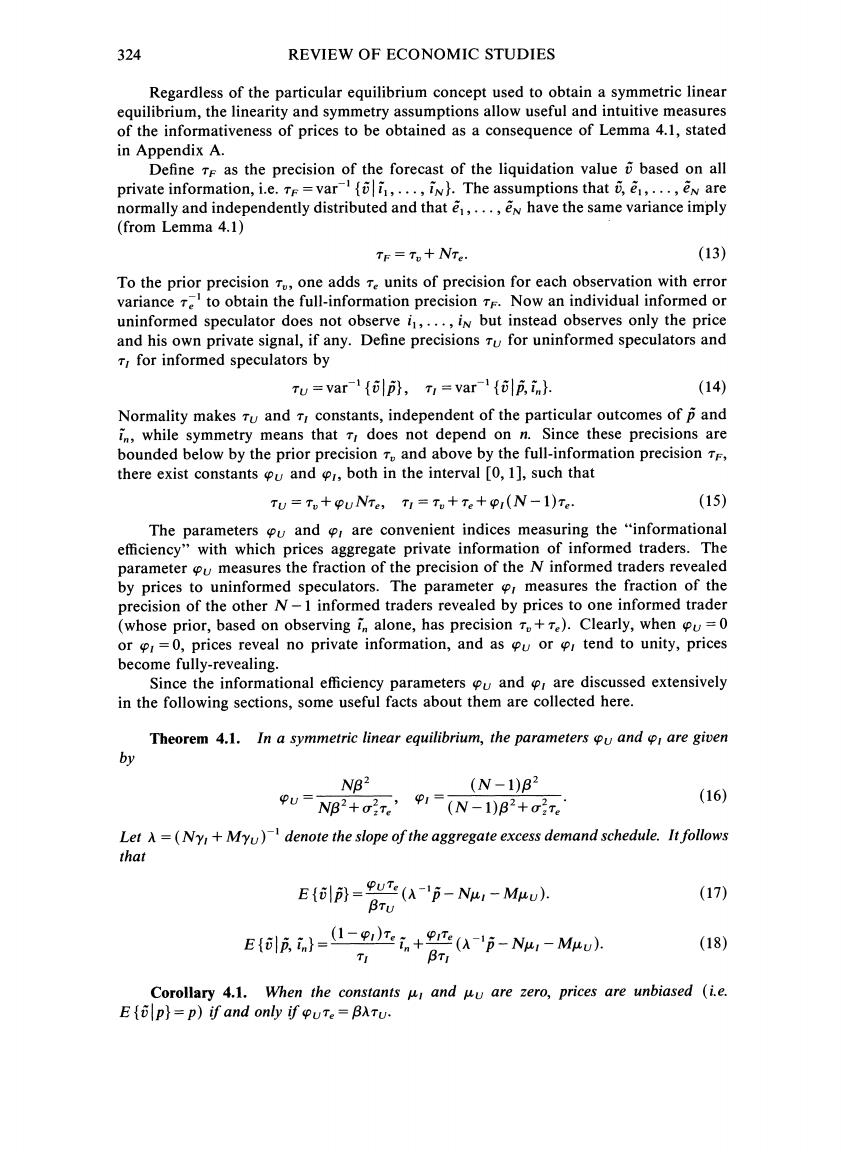
324 REVIEW OF ECONOMIC STUDIES Regardless of the particular equilibrium concept used to obtain a symmetric linear equilibrium,the linearity and symmetry assumptions allow useful and intuitive measures of the informativeness of prices to be obtained as a consequence of Lemma 4.1,stated in Appendix A. Define TF as the precision of the forecast of the liquidation value based on all private information,i.e.T=var,...,iN).The assumptions that ,...,en are normally and independently distributed and that e1,...,ew have the same variance imply (from Lemma 4.1) TF =To+NTe. (13) To the prior precision To,one adds Te units of precision for each observation with error variance re to obtain the full-information precision TF.Now an individual informed or uninformed speculator does not observe i1,...,in but instead observes only the price and his own private signal,if any.Define precisions Tu for uninformed speculators and T,for informed speculators by TU =var p),TI=var p,in) (14) Normality makes ru and T constants,independent of the particular outcomes of p and in,while symmetry means that Tr does not depend on n.Since these precisions are bounded below by the prior precision To and above by the full-information precision TF, there exist constants and both in the interval [0,1],such that TU=To+PuNTe,TI=To+Te+pi(N-1)Te. (15) The parameters u and r are convenient indices measuring the "informational efficiency"with which prices aggregate private information of informed traders.The parameter u measures the fraction of the precision of the N informed traders revealed by prices to uninformed speculators.The parameter or measures the fraction of the precision of the other N-1 informed traders revealed by prices to one informed trader (whose prior,based on observing in alone,has precision T+re).Clearly,when u=0 orr=0,prices reveal no private information,and as u or tend to unity,prices become fully-revealing. Since the informational efficiency parameters u and r are discussed extensively in the following sections,some useful facts about them are collected here. Theorem 4.1.In a symmetric linear equilibrium,the parameters pu and o are given by NB2 (N-1)B2 PU-NB2+I(N-1)B+ (16) Let A=(Ny+Myu)denote the slope of the aggregate excess demand schedule.Itfollows that E(p)=PuT (A-6-Nu-Muu). (17) BTu E)=(A--Nur-MuU). (18) TI BTI Corollary 4.1.When the constants w and uu are zero,prices are unbiased (i.e. E{p}=p)if and only if ouTe=BATu
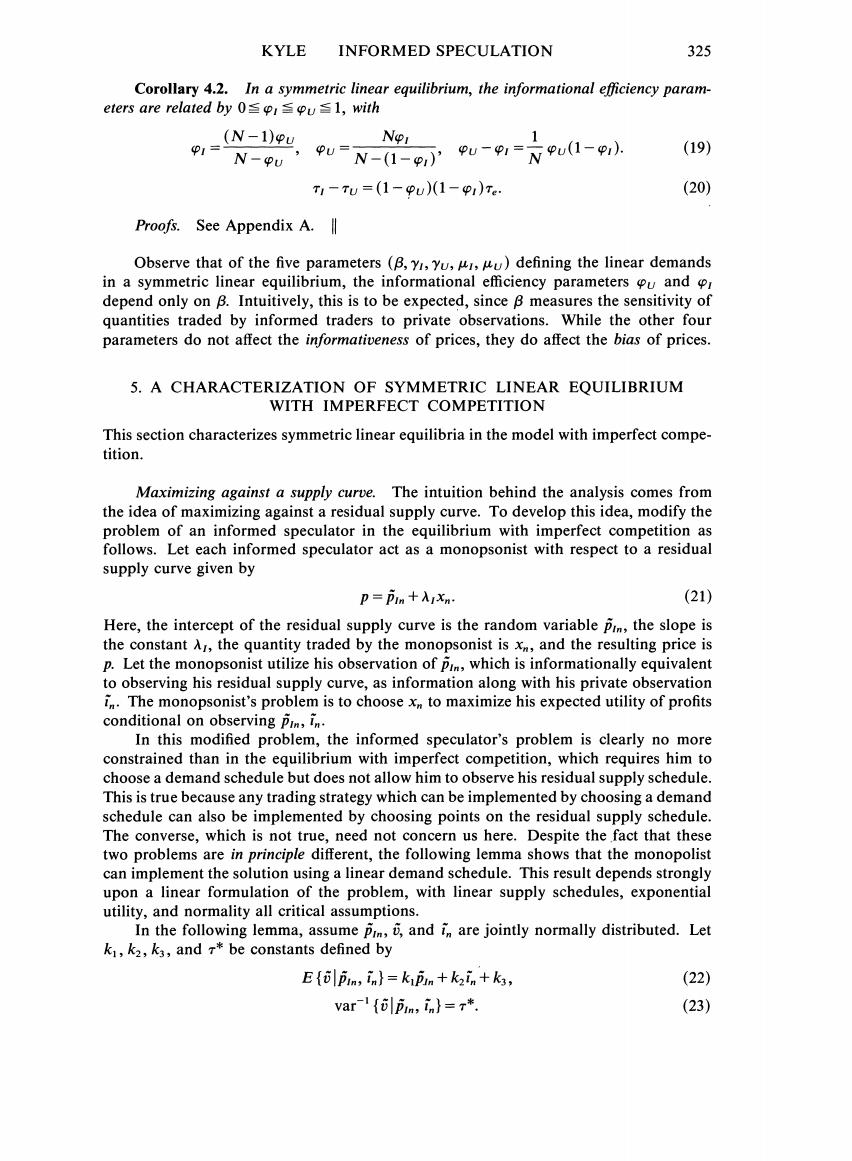
KYLE INFORMED SPECULATION 325 Corollary 4.2.In a symmetric linear equilibrium,the informational efficiency param- eters are related by 01,with (N-1)Pu Nor P1= N-PU-N-(1)PU-PI-NPU(1-P1). (19) T1-Tu=(1-pu)(1-p1)Te (20) Proofs.See Appendix A. Observe that of the five parameters(B,yi,Yu,ur,u)defining the linear demands in a symmetric linear equilibrium,the informational efficiency parameters u and pr depend only on B.Intuitively,this is to be expected,since B measures the sensitivity of quantities traded by informed traders to private observations.While the other four parameters do not affect the informativeness of prices,they do affect the bias of prices. 5.A CHARACTERIZATION OF SYMMETRIC LINEAR EQUILIBRIUM WITH IMPERFECT COMPETITION This section characterizes symmetric linear equilibria in the model with imperfect compe- tition. Maximizing against a supply curve.The intuition behind the analysis comes from the idea of maximizing against a residual supply curve.To develop this idea,modify the problem of an informed speculator in the equilibrium with imperfect competition as follows.Let each informed speculator act as a monopsonist with respect to a residual supply curve given by p=pPin+Arxn. (21) Here,the intercept of the residual supply curve is the random variable prm,the slope is the constant A,the quantity traded by the monopsonist is x,and the resulting price is p.Let the monopsonist utilize his observation of pim,which is informationally equivalent to observing his residual supply curve,as information along with his private observation i.The monopsonist's problem is to choose x to maximize his expected utility of profits conditional on observing Pim,in. In this modified problem,the informed speculator's problem is clearly no more constrained than in the equilibrium with imperfect competition,which requires him to choose a demand schedule but does not allow him to observe his residual supply schedule. This is true because any trading strategy which can be implemented by choosing a demand schedule can also be implemented by choosing points on the residual supply schedule. The converse,which is not true,need not concern us here.Despite the fact that these two problems are in principle different,the following lemma shows that the monopolist can implement the solution using a linear demand schedule.This result depends strongly upon a linear formulation of the problem,with linear supply schedules,exponential utility,and normality all critical assumptions. In the following lemma,assume pi,and in are jointly normally distributed.Let k1,k2,k3,and T*be constants defined by E pin;in}kipin +k2in+k3, (22) var(pin,in)=T*. (23)
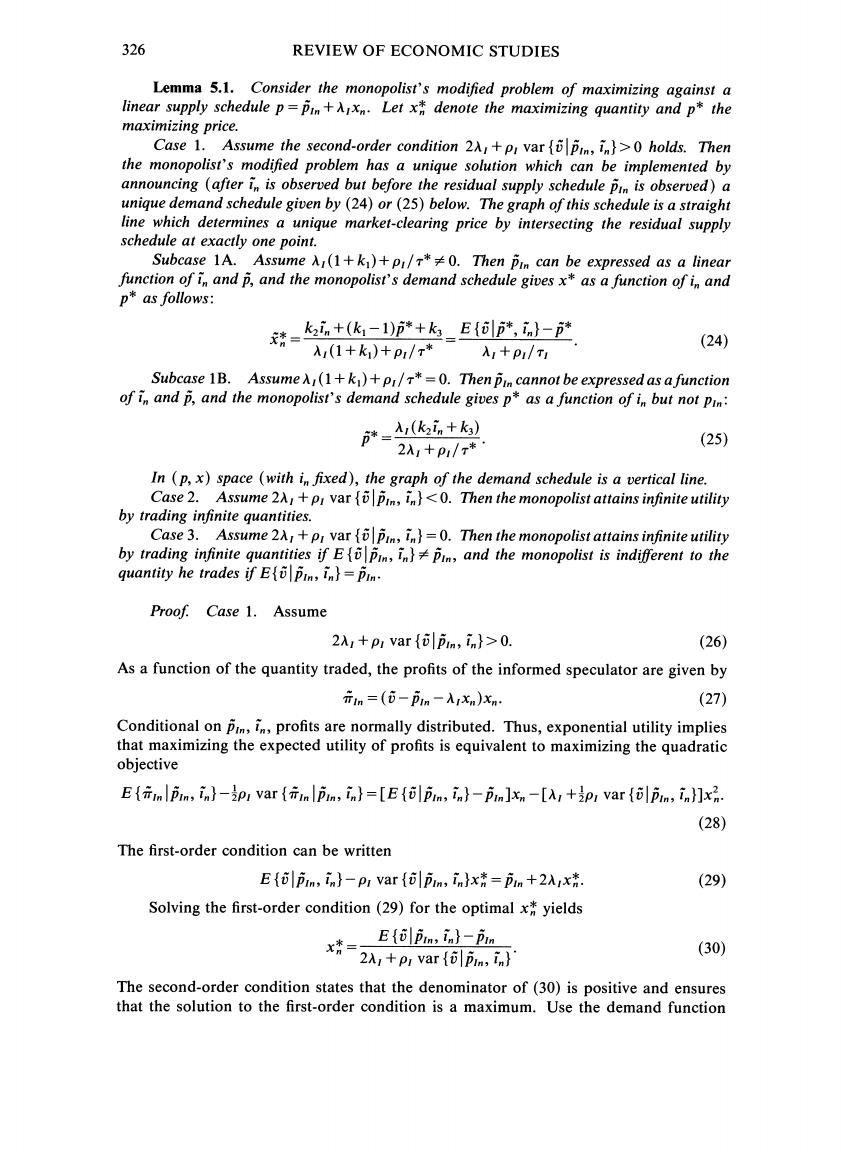
326 REVIEW OF ECONOMIC STUDIES Lemma 5.1.Consider the monopolist's modified problem of maximizing against a linear supply schedule p=pin+x.Let x denote the maximizing quantity and p*the maximizing price. Case 1.Assume the second-order condition 2A1+p var pin,in)>0 holds.Then the monopolist's modified problem has a unique solution which can be implemented by announcing (after i is observed but before the residual supply schedule pin is observed)a unique demand schedule given by(24)or(25)below.The graph of this schedule is a straight line which determines a unique market-clearing price by intersecting the residual supply schedule at exactly one point. Subcase 1A.Assume Ar(1+k)+p/*0.Then pin can be expressed as a linear function of i and p,and the monopolist's demand schedule gives x*as a function of in and p*as follows: 济=。+k,-1)+k_E创方速,- 入(1+k)+P/r* (24) 入,+P1/T1 Subcase 1B.AssumeA(1+k)+p/*=0.Then pin cannot be expressed as afunction of i and p,and the monopolist's demand schedule gives p*as a function of i but not pin: p*=(飞+k) 2入1+P1/x* (25) In (p,x)space (with in fixed),the graph of the demand schedule is a vertical line. Case 2.Assume 2A1+pI var pin,in}0. (26) As a function of the quantity traded,the profits of the informed speculator are given by 元in=(i-P1nm-入xn)xn (27) Conditional on pim,in,profits are normally distributed.Thus,exponential utility implies that maximizing the expected utility of profits is equivalent to maximizing the quadratic objective E{fm pin,in}-ipI var {fin pin,in}=[E pin,in}-pin]xn-[Ar +ipI var pin,in)]xn. (28) The first-order condition can be written E pin,in}-pi var {o pin,inx=pin +21x (29) Solving the first-order condition(29)for the optimal x yields E pin,in)-pin =2入1+pvar{i, (30) The second-order condition states that the denominator of(30)is positive and ensures that the solution to the first-order condition is a maximum.Use the demand function